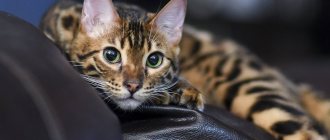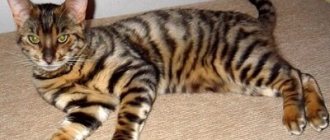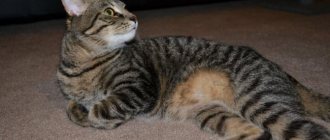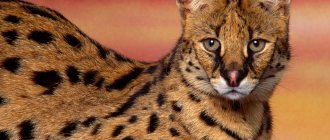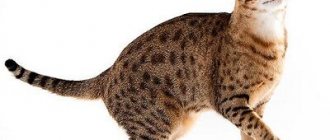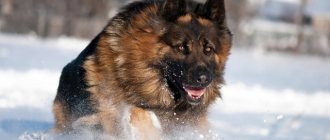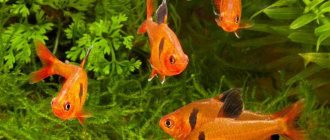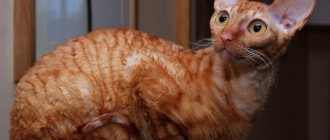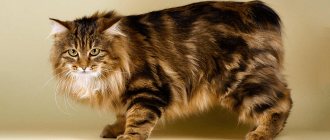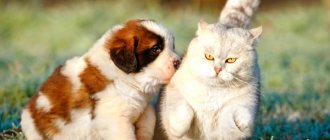Video
* We invite you to watch a video about the Nibelung . In fact, in front of you is a playlist in which you can select and watch any of 20 videos about a given cat breed by simply clicking on the button in the upper right corner of the window. In addition, the material contains quite a lot of photos. By looking at them you can find out what the Nibelung looks like.
In this article:
|
Rate the material!
[Total votes: 2 Average: 5]
Nibelung cat breed is not very popular, but it has managed to win its army of admirers. Even despite the fact that the breed is relatively young. Its representatives are distinguished by their beautiful fluffy, ash-colored fur coat and a special way of thinking. Nibelung cats are bred with the goal of having a calm, good-natured and loyal friend.
Minuses
Due to intolerance to some foods, you should be careful about the Nibelung's diet.The cat loves silence, and noisy places will become a source of constant stress for it. During her departure, it will be difficult to leave her with other people, because strangers will definitely cause her mistrust.
Also, few catteries breed cats, and there is a risk of accidentally taking an initially sick pet or purchasing a representative of a different breed.
History of the origin of the Nibelungs
The Nibelung cat breed appeared in the early 80s in the USA. The breed's biography is relatively short. The word Nibelung itself is literally translated from German as “creature of fog.”
The appearance of the Nibelung breed is due to chance. One day, an American cat breeder named Core Cobb took in a kitten that was strikingly different from everyone else in the litter, as it was a uniform blue color with incredibly beautiful and shiny fur. The kitten was the result of a connection between an ordinary domestic shorthair cat and a Russian Blue cat.
Another kitten was adopted from the next litter from the same domestic cat and a Russian Blue cat. This time it was a girl with the same uniform blue color, but with longer hair. By crossing these two cats, Cora Cobb gave birth to a new breed.
Interesting fact: Externally, the breed is similar to the Russian Blue cat, but unlike it, it has longer hair. Since the first two cats that gave birth to the breed were named Siegfried and Brünnhilde, the names of the heroes of Wagner’s opera “The Ring of the Nibelungs,” it was decided to name the breed with this very word.
Of course, there were certain problems during registration, since the owners and breeders of the Russian Blue cat did not agree that this was a new breed. But just a few years later, in 1987, the breed was still registered, and in 1997 it was even awarded champion status.
In Russia, the breed originated in the Russian Blue cattery. In one of the litters of titled cats, a kitten with very long hair appeared, but Russian canine systems could not determine its breed. And only at the exhibition an American expert identified the animal as a Nibelung breed. This representative of the breed of Russian origin was many times ahead of the American ones in its quality indicators.
The first Russian Nibelung was named Sedge, and at that exhibition she won the largest number of awards.
Interesting Facts
The mysterious Nibelung
The Nibelung breed is still new, but has managed to acquire interesting stories.
- By nature, Fog cats are in many ways similar to dogs. Owners of these two types of pets notice this.
- Newborn kittens have yellow eyes; at 4 months some green eyes appear. Only at 2 years old do they become a rich emerald color.
- All new objects that come into the field of vision of the Misty Cat will definitely be sniffed and examined. She can walk for a long time nearby. After making sure that the object is safe, the animal jumps onto it.
- There is only one nursery in Russia where you can book a Nibelung.
Nibelung - description of the breed
Representatives of the breed can be described as graceful small cats. But at the same time, the body of the animal is well built and knocked down.
The animal's fur coat is particularly beautiful. The Nibelung's coat is long and textured, soft and silky. The guard hair is of medium length and fine. The undercoat is fluffy and soft. As the weather gets colder, the fur lengthens and becomes thicker. The pet's coat does not fall off. Complete formation of the coat occurs by two years.
International standards dictate the following characteristics of the breed:
- Smoky uniform color;
- A coat of soft, silky, long wool with a soft undercoat. The hair on the tail is longer than on the body;
- The cat's body is long and muscular;
- After 2 years, eye color becomes bright green, with a possible yellow tint. The best option is a rich green eye color;
- The large head is wedge-shaped;
- Wide at the base, large ears, pointed towards the end, slightly tilted forward;
- The limbs and neck of the animal are long;
- The tip of the nose and paw pads are colored light gray;
- Males have a dense scruff. Females also have it, but not so pronounced;
- The fluffy tail of cats is long, its length is equal to the length of the body. It is pointed at the end;
- On average, an adult pet weighs from 3.5 to 6 kg;
- The height at the withers is on average 25 cm.
The Nibelung is a graceful, mannered and slender animal. The cat is brave. At some moments her arrogance shows. So, in the morning, a Nibelung will easily wake up its owner if it wants to eat.
Interesting fact: Cats are much fluffier than cats.
Representatives of the breed live from 12 to 15 years with proper care. There are cases when an animal lives up to 20 years.
Breed standard according to the WCF system
The pedigree of the Fog Cat is determined according to the established standard.
The basic criteria for the Nibelung breed according to the international WCF system are presented in the table:
| Head | Wedge-shaped, with prominent, high-set cheekbones and clear boundaries. Externally, the skull has soft outlines, and due to the dense fur it appears spherical. The forehead and nose form an almost right angle on the bridge of the nose. |
| Nose | Tapered, smooth and long. The color of the “patch” is light blue. |
| Eyes | In the shape of tonsils, slightly elongated horizontally, widely spaced. Color – deep green. Kittens have a topaz tint, which changes to a standard color with age. |
| Neck | Medium length, thin and graceful. |
| Body | Elongated, graceful, muscular, with correct proportions. |
| Paws | Not particularly long, but not short either. Slender, muscular, developed. There are “pants” on the hind legs. The paws are compact with tightly clenched toes, between which hair sticks out. The pads are oval. |
| Tail | The same length as the body. Evenly covered with fur. The tip is slightly rounded. |
| Vibrissae | They protrude slightly without disturbing the wedge-shaped shape of the head. |
| Ears | Large, with rounded tips, the same width along the entire length. Located far apart from each other, slightly tilted forward. Due to the absence of edges inside, they seem thin and translucent. |
| Wool | Medium length with visible undercoat. The fur is longer near the tail and on the shoulders. Silky to the touch. The collar zone is more pronounced in males. |
Popular colors of Nibelungs
Nibelungs come in only one solid color and one ash color. Breeders call this color blue. In fact, the coat color of this breed is pale gray. The presence of any colored marks, patterns or inclusions on the coat are signs of disqualification of a representative of the breed.
Today there is an opinion that the gray color of a cat indicates its noble origin. Since the Nibelung cannot have any color other than gray, this cat is automatically classified as a “blue blood” animal. Another cat breed has the same privileges - the Russian Blue cat.
The name of the breed is associated with the color of the animal. Translated from German, Nibel means a foggy creature. Representatives of this breed have a beautiful shimmering silver-blue coat. The shimmer is achieved through the silveriness of the lighter ends of the main hair of the cat's coat. It is the discoloration of the tips that creates the image of haze around the cat.
Interesting fact: At first glance, the cat's fur color appears to be true gray, but if you look closely, you can see a silvery blue color. The Nibelung's coat is always distinguished by its healthy, rich color.
It is impossible to meet a kitten of this breed with a color that is distinctive from the ash color. A special feature of the Nibelung is its ash color with a blue tint. The exception is the light gray color. Therefore, a kitten of this color is not a cull.
Tiger stripes may be present on the fur of kittens that have just been born, but after a certain time they will definitely disappear.
Wool
Wool is the main advantage of the breed. Photos of Nibelung cats will certainly delight every animal lover. Thin and thick fur does not fit tightly to their body, which is why they resemble a small cloud.
Therefore, the name of the breed is translated as “child of the fog.” Color options range from light gray to dark blue with a silver tint.
Character and habits of the Nibelungs
Cats of this breed like space. They will feel more comfortable in a large house than in a small apartment. Outdoor cats lead an active lifestyle, while in an apartment they are very reserved. By nature, the Nibelung is a hunter, so they are ready to wait for prey in the garden for hours. They do not hesitate to eat a caught bird or rodent.
The Nibelung is a very noble cat. He will never impose himself on his owner. This breed does not tolerate loneliness; for complete satisfaction the animal only needs to be within walking distance of the owner.
They do not show aggression towards strangers, but behave with them extremely carefully. Trust in a stranger will come, but it will take a long time. Representatives of this breed are very picky about people. Communication with them must be earned. As a rule, the Nibelung chooses only one family member as its full owner and communicates exclusively with him.
A distinctive feature of this breed is the “silence” of the pet. The voice of a cat can be heard extremely rarely, only when absolutely necessary. Therefore, people who prefer silence get such a cat.
The Nibelung is a very smart cat that is easy to train. But they don’t like to do anything and don’t do anything under pressure. Therefore, for training it is necessary to obtain their consent and achieve their favor.
Cats of this breed are kind and playful, but do not like being forced to play. They cannot bear the torment at all. Therefore, a pet of this breed is not suitable for families with small children. Cats do not like excessive attention to their person. They need to be in company, but at the same time on their own.
Interesting fact: Separation from the owner is a difficult test for the Nibelung, he is very attached to the owner, so he gets bored in his absence.
Representatives of this breed get along well with other pets, even cats or dogs. Some owners even make a special friend for the Nibelung. The main thing is not to choose a pet that is too active, otherwise the temperament of the animals will not match, and friendship between them will not work.
How to choose a Nibelung
Since the breed is considered quite rare, it will not be possible to find its representatives in the first nursery.
You need to contact a professional breeder and be sure to check the documents for the cat. Sellers often give long-haired kittens to gullible buyers under the guise of Nibelungs.
You will also have to pay a considerable amount for a pet. The price of a Nibelung cat can reach up to 80 thousand rubles.Interesting facts about the Nibelungs
All kittens of this breed are born with yellow eyes. At four months, a green ring appears around the pupil. By the age of two, cats' eyes become deep green.
Nibelungs are characterized by increased curiosity. Everything that comes into the house where they live must be studied by them. Before he gets close enough to smell the object, the pets will circle around it for a long time. If the cat understands that the object does not threaten its safety, it will definitely jump on it.
There is another theory about the origin of this breed. Allegedly, in each litter of the Russian Blue cat there were kittens with long hair, but otherwise identical to their mother. At first they were considered a culling breed. Over time, breeders decided to create a new breed from these discarded individuals. The breeders really liked the animal’s unusual, beautiful fur coat.
Nibelung kittens are very easy to train. That is why it will not be difficult for the owner to teach the baby to relieve himself in the tray. For some pets, it is enough to show the place of the toilet once and they will only go there. The main thing is that the tray is always clean, since Nibelungs are very clean animals.
By nature, cats of this breed are hunters. They enjoy catching game in the yard. However, they also will not disdain to feast on a domestic rodent or bird. Even despite the fact that they will be friends with this pet.
The average life expectancy is 15 years. But history records a fact when a representative of this breed lived a life of 36 years. There was a case when a Nibelung cat climbed a tree and did not get down for 6 years. During this time, she managed to acquire three offspring.
Care and maintenance
Nibelung cats are quite capricious in terms of care. The peculiarities of their coat require a careful and careful approach to grooming. That is, there are a number of rules on how to properly maintain the health and beauty of an animal.
- About wool
. The thick, long hair of these amazing American inhabitants should be brushed once a week. And experts recommend bathing them as rarely as possible. If water procedures are necessary, then colored shampoos should never be used to wash your pet. This can harm the cat's fur pigment. Breeders also advise avoiding sunbathing, as this will cause the color of the cat's coat to fade.
- Nutrition
. It is better to start feeding Nibelungs with natural food. If desired, by adding a little food to the diet, you can gradually switch them to it. But veterinarians recommend continuing to keep “foggy” Americans on fresh food. It’s easier to spend some time creating a balanced menu with added vitamins, and not worry about the cat’s well-being.
- And perhaps the most important point - keeping the litter tray, bowls and house generally clean
. Nibelungs are very clean and fastidious. If they don't like the smell of food, they will ignore it, and if they find that the litter box was not cleaned in time, they will go to the toilet somewhere else.
Diseases of the Nibelung breed
In general, this is a healthy and hardy breed, which has been spared genetic diseases and other serious ailments. Periodic visits to the veterinarian's office and timely vaccinations will ensure your cat has a long and peaceful life.
Purebred Nibelungs live about 12-15 years.
Conclusions about the breed
global $ads_google;
//data-ad-slot=”2475549904″ $ads_google = empty($ads_google) ? false : true; ?> if ($ads_google == false) {?> $ads_google = true; ?> } ?> Nibelung is... :
- An elegant purebred representative of the cat world. Animals with a luxurious silver-blue silky coat are a source of pride for breeders around the world. Although it is still almost impossible to meet them in the average family. Model individuals more often either do not leave their native nursery at all or move to another. And since they are in good health, there are almost no cats with any disabilities.
- A cat that loves its owner and is friendly with other people and animals. However, communication skills must be developed in this quiet, homely tidy from birth. Otherwise, the cat may turn into an unsociable, timid animal.
- Refined conservatives. Nibelungs of any changes and have difficulty getting used to something new. For this reason, you need to be patient and forgiving when dealing with them.
Pros and cons of the Nibelungs
All cat breeds have both positive and negative sides. The Nibelung breed is no exception, although its advantages outweigh its disadvantages.
Advantages of the breed:
- Beautiful appearance and charming color;
- Good health and strong immunity;
- Good-natured disposition. Never show aggression towards family members;
- Flexibility to training;
- Devotion to the owner;
- Not difficult and not expensive care;
- Excellent convergence with other animals. Shows friendliness, the main thing is that the animals have similar temperaments;
- Unpretentiousness;
- Cleanliness.
Disadvantages of the breed:
- Distrust of strangers. To gain the trust of this breed, a person will have to make a lot of effort;
- Only one family member is recognized as the owner;
- They do not get along with small children because they cannot tolerate forced play;
- They require careful grooming. The influence of sunny color has a negative effect on the color of the coat;
- It is difficult to adapt to new conditions;
- Cannot tolerate noise and disorder;
- For a comfortable existence, a cat needs free space. It is advisable to have this breed for people who live in houses and have a spacious yard.
Reviews from owners of this breed indicate that Nibelungs are the best pets. They are distinguished by a special mindset and flexible character.
Temperament of the Nibelungs
Nibelung cats are quite controversial natures. On the one hand, they do not particularly annoy with their presence, but they do not refuse affection either. At the same time, loneliness is difficult for them to bear; the presence of the owner nearby is important. They are ready to catch the glare of the sun in excitement, but immediately stop the game at the first request. On the street, cats are too active, but at home they are the embodiment of calm and restraint. Having a natural instinct as a hunter, Nibelungs are ready to watch their prey for hours. Often their victims are small birds or rodents.
Nibelungs are born hunters
The Nibelung will be friendly with all family members, but the owner is always a priority. He is wary of strangers until he is convinced of their harmlessness. But this takes time. He is picky about people and not everyone can earn his favor. Communicates through a faint rumbling, sometimes capable of meowing loudly, expressing his displeasure for some reason.
In terms of order and cleanliness, the Nibelung can be called a conservative. Such a cat requires comfort and stability, since it takes a long time to adapt to sudden changes in conditions. He quickly understands that he needs to relieve himself in the tray. The developed intelligence of the foggy pet is manifested not only in basic everyday things, but also during the game - it always finds non-standard maneuvers.
Nibelungs do not tolerate scandals and loud sounds. Finding themselves in such a situation, they immediately hide or attack the source of noise.
Breeding Nibelungs
The female of this breed reaches childbearing age at 9 months, so often by 12 months the Nibelung already has her first offspring.
Breeders who are engaged in pedigree breeding allow a cat of this breed to mate for the first time only a year and a half after the second or third heat. I allow females who have completely stopped feeding kittens to cover. Therefore, cats are not mated during the first heat after giving birth.
Cats are only ready for mating during estrus, which usually lasts 7 days, while mature cats are ready to coat all the time. During estrus, the female Nibelung becomes affectionate and with all her appearance shows her readiness for mating.
The peak of sexual activity in cats is the warm season. Breeders should take this into account. If animals are mated early, unhealthy kittens may be born. The same negative result can result from mating a cat that has not yet had time to recover from giving birth.
The ideal option for mating an animal is once a year, but in any case not more than 2 times a year. On average, a Nibelung litter contains 3–6 kittens. Kittens are born with straight ears that curl slightly. Until the ears are completely level, petting animals on the head is not recommended.
Important fact: Kittens must be vaccinated. Until this moment, bathing them is prohibited. Once a week, the baby's coat should be combed with a wide-toothed comb, which will remove dirt well.
It is not recommended to give kittens of this breed to a new owner before 3 months. Until this moment, they must undergo a course of socialization and acquire strong immunity.
Health and susceptibility to disease
The Nibelung breed boasts excellent health.
The Nibelung breed is famous for its good health, subject to proper care and a balanced diet. But they also get sick from time to time. They are characterized by the same diseases as the Russian Blue:
- diabetes:
- kidney pathologies;
- stones in the ureters;
- cystitis;
- hyperthyroidism.
The average life expectancy of Nibelung cats is about 15 years. But there is one fact in history about a centenarian who died in her fourth decade.
Vaccinations and antiparasitic treatment
Nibelungs are required to be vaccinated as a preventive measure against the following diseases:
- rhinotracheitis;
- panleukopenia;
- calcivirus
The first vaccination is given to a kitten when it reaches the age of 8 weeks. A month later, the procedure is repeated exactly, but with anti-rabies inclusion. In the future, the cat is taken to be vaccinated once a year.
Antiparasitic treatment is carried out once every six months. This helps protect your pet from diseases that can be contracted from worms and fleas. Drugs that destroy helminths are given twice with an interval of 10-12 days. For fleas, use special shampoos and drops. Nibelungs who are often outdoors are equipped with an anti-flea collar.
Sterilization and castration
When a cat of the Nibelung breed is adopted for pleasure, without further breeding, sterilization (castration) is recommended. The procedure is carried out before the first mating, provided the animal is 7 months old. In this way, it is possible to avoid behavioral changes, as well as possible complications in the genitourinary system.
Caring for Nibelungs
The cat's luxurious coat requires special care. The beautiful ashy color of the animal easily fades under ultraviolet light, so experts recommend not letting the animal play under the scorching sun. Otherwise, unsightly brown spots may appear on the coat, which will only go away during the molting period. To ensure that the fur remains attractive during shedding, the pet must be given nutritional supplements.
The animal's ears also require regular care. To prevent various ear diseases, the ears must be examined and cleaned of dirt with a swab containing peroxide. This will prevent the occurrence of a number of diseases that lead to deafness in your pet. It is recommended to rinse your eyes with boiled water or chamomile infusion once a week. If swelling or redness appears, you must promptly contact a veterinarian in order to promptly prevent eye diseases.
Bath procedures should be carried out only in cases of special need. Nibelungs have a hard time taking baths because they are afraid of water. Therefore, it is necessary to bathe them only when they get dirty. Frequent bathing removes the fat layer on the animal's skin, which protects cats from colds. To remove dust and dirt, experts recommend combing the animal more often. Although this breed is particularly clean, they are excellent at keeping their body clean on their own.
Frequently brushing your pet not only has a beneficial effect on its health, but also allows you to establish a psychological relationship with the owner. The main thing is that the animal does not experience fear or discomfort during the procedure. The pet will not cause damage to the interior of the room if a special scratching post is installed for it. But your pet’s claws still need to be trimmed regularly once a quarter. Only the transparent part of the nail should be trimmed.
Colors
The wool of the Nibelungs is colored blue, in different shades, colors. There is tipping – i.e. the tips of the hairs are painted a certain color. This creates the effect of a shining halo. Tipping can be bright or weak, but the color of the coat should always be rich and deep.
Expert opinion
Dusheba Vera Ivanovna
In 2010, she graduated from the Moscow State Academy of Veterinary Medicine named after K.I. Scriabin with honors, specializing in veterinary medicine. I regularly attend veterinary conferences, congresses, and webinars.
Breeders do not advise allowing your pet to walk under the scorching sun: bright light can ruin the unique color of the coat - it will simply fade.
In the photo there is a cat of the Nibelung breed
Diet of the Nibelungs
The diet of an adult must be balanced and complete. The menu should not be too plentiful so that the pet does not suffer from obesity. An animal's taste preferences are formed at an early age, so it is difficult to wean an adult off treats from the table if the cat is accustomed to receiving them regularly.
The main thing to remember is that cats should not eat from the general word, since not all human food is healthy for them. Cats are prohibited from giving sweets, canned food, smoked foods, fatty and fried foods. Due to poor nutrition, your pet may experience health problems, including digestive system disorders, stomach disease, and kidney and liver dysfunction. The Nibelung's diet should be developed from an early age.
The main products of a cat's menu should be:
- Meat;
- Fish;
- Vegetables (except carrots and beets);
- Porridge (except buckwheat);
- Milk products.
The diet of kittens is very different from the diet of adults. Starting from the second month of their life, they do not have enough cat milk, so additional complementary foods should be given. Milk oatmeal and chicken eggs can be safely given to a kitten. A little later, you can gradually introduce boiled beef, chicken, fish and cottage cheese into the menu.
Important fact: Kittens need to eat 5 times a day. As babies grow, the number of meals decreases and portions increase. Adults eat 1 or 2 times a day.
When feeding Nibelungs naturally, it is forbidden to give liver, carrots, beets, buckwheat and other foods that contain iodine and copper. Since the consumption of such products negatively affects the color of the cat's coat. You can choose ready-made food as food. It is better to give preference to premium quality coma, since it is fully balanced and contains all the necessary beneficial elements and substances.
Catering
Cats of this breed can be fed both natural food and commercial food. But remember: you will have to choose one thing, since doctors do not recommend giving the Nibelungs one or the other alternately. Balance, the required amount of minerals and vitamins - this is the main requirement for food. What can and should be included in the menu?
Natural products
- Meat: beef, veal, rabbit, chicken, turkey. Lamb meat is also allowed. But pork and duck meat are not allowed: they are difficult for a cat’s delicate stomach, and in addition, they are often infected with parasites. Meat should be given daily, after dousing it with boiling water and cutting it into pieces. Kids are allowed to make minced meat.
- Offal: hearts and ventricles, boiled liver (raw liver causes vomiting), chicken necks, ground into minced meat.
- Fish: only sea fish. These are salmon, hake, trout, sardines and other low-fat varieties. River fish can be toxic to cats. Give no more than once a week, since an excess of fish dishes leads to the development of urolithiasis (and Nibelungs are already prone to this disease). Shrimp and squid are allowed.
- Porridge: rice, oatmeal, buckwheat, pearl barley, millet. The porridge is cooked in water, only semolina is cooked in milk (liquid semolina is used to supplement kittens up to 3 months of age). Can be given 4-5 times a week.
- Vegetables: carrots, pumpkin, zucchini, green beans, cauliflower, greens (parsley, dill, spinach, lettuce), bran. Some cats happily eat vegetables raw, while others need to boil them and mix them with cereal or add them to meat broth. Add to the diet daily.
- Fermented milk products: natural yoghurts, kefir, fermented baked milk, sour cream, cottage cheese, yogurt, cheese. Products should be low-fat, free of dyes and other dangerous additives, preferably unsalted. Can be fed daily.
- Eggs: give whole quail eggs a couple of times a week, boil chicken eggs and feed only the yolk (you can give them 3-4 times a week).
- Oils: vegetable, olive, butter. They are added in small quantities (literally a few drops) to porridge.
- Sprouted oats or wheat. You can't give grass from the street!
Expert opinion
Dusheba Vera Ivanovna
In 2010, she graduated from the Moscow State Academy of Veterinary Medicine named after K.I. Scriabin with honors, specializing in veterinary medicine. I regularly attend veterinary conferences, congresses, and webinars.
Make sure your pet always has access to clean, cool water. It is changed regularly: in the mornings and evenings, and also when it gets dirty. It is recommended to buy bottled water, pass tap water through a filter, or let it sit for 6-8 hours. It is believed that boiled water increases the risk of developing urolithiasis.
Vitamin and mineral supplements are given only after consultation with a veterinarian, as is dry brewer's yeast.
Prohibited list of products:
- Pork, goose meat (both fillet itself and offal);
- Fatty fish, river fish - carps are strictly prohibited;
- Internal fat, lard, tripe, bones, skin;
- Sweets: chocolate, marmalade, marshmallows, marshmallows, etc.;
- Onion and garlic;
- Tomatoes, eggplants, potatoes, peas, chickpeas, mushrooms, sorrel, rhubarb, broccoli;
- Grapes, avocado, raisins, persimmons, citrus fruits;
- Seeds, nuts;
- Pasta, baked goods, salty, smoked, sweet;
- Raw chicken protein;
- Whole cow's milk;
- Coffee, tea, mineral water, alcohol, soda, juices;
- White cabbage;
- Sauces, mayonnaise, seasonings, spices;
- Dog food.
Kittens under 3 months of age are fed up to 6 times a day, from 3 to 4 months - 5 times, from 4 to 6 - 4 times, over 6 - 2 times, like an adult animal.
In the photo there is a kitten of the Nibelung breed
Food should be at a comfortable temperature: neither cold nor hot. Train your cat to eat in the same place, from its own dishes. It is advisable to wash bowls after each meal: Nibelungs are squeamish and will not eat from dirty dishes.
Recommended food
When choosing dry food, it is advisable to choose holistic and super-premium food. Economy class food does not bring any benefit to animals. And premium food in some cases causes allergic reactions. And the percentage of nutrients in both is too small. Feed samples: Innova Evo, Almo Nature, Pronature Original.
Below are recommended super-premium foods. Links with the names of the food are clickable, on them you can, within our website, get acquainted with the descriptions of the food and read reviews from owners of Nibelung cats.
| Premium | Super premium | Super premium |
| Bozita | SUPERPET | Organix |
Diseases and health problems
Nibelungs are a non-sick cat breed. They do not suffer from genetic diseases at all. This breed is an exception to the rule where all genetically bred animals have poor health. Nibelungs have good health, which can even be the envy of some yard cats. Of course, they tend to suffer from common diseases, just like other living beings.
Nibelungs experience ailments that are typical of long-haired cats. While walking on the street, an animal may well pick up fleas or ticks, lichen or helminths. Although Nibelungs rarely get sick, it is still worth taking them to the veterinarian periodically to get advice on how to keep the cat healthy or how to treat it.
Every self-respecting cat owner should know and be able to distinguish the following symptoms of diseases:
- Poor appetite, which is accompanied by severe thirst;
- Lethargy and apathy, complete indifference to favorite things;
- Stiffness in limb movements;
- Lives quite hard and enlarged;
- Discoloration of the inside of the ear;
- Dull and lackluster coat;
- Ulcers and wounds on the skin;
- Increased secretion of saliva and tears;
- leaking ears, nose, or eyes;
- urinating more often than usual;
- Blood in stool;
- Vomiting, diarrhea, constipation.
All these symptoms indicate that the Nibelung is sick and needs help. The sooner he gets it, the better. Timely vaccination will help avoid a number of cat diseases. There are certain rules that should be followed when getting vaccinated. 14 days before the vaccination itself and 14 days after it, it is advisable not to change the animal’s diet. 10 days before vaccination, it is necessary to prevent worms by treating them.
A mandatory vaccination for all domestic cats is a rabies vaccination, which is given to them at the age of three months. It should be done in the nursery. At the age of eight months, the kitten is vaccinated against leukemia, and also receives FIE, FVR and FCV vaccines. All vaccinations must be done by a specially trained person, and information about vaccination is entered into a special card created for the pet.
Life preferences of the breed
With their small size, these creatures can feel equally at home in both apartments and country houses. But they need enough space. These cats have a well-developed hunting instinct. They will be happy to devote a long time to this activity, tracking down birds and mice. These royalty rarely express aggression. They are very playful and do not tolerate loneliness well; they can even do minor mischief in the absence of their owner in order to attract his attention.
If you are away from home for a long time, then get your Nibelung a friend: a dog or another cat with whom he will while away his loneliness.
Smoky people are wary of strangers and prefer to hide and evaluate the behavior of the guest. They behave much more heroically when the vacuum cleaner is working: they climb higher and patiently wait for the time when this disgrace will end.
To avoid damage to your favorite furniture, you need to place a scratching post in the room. It is imperative to monitor the cleanliness of the cat's litter box and the dishes from which you feed the animal. This will minimize all troubles.
You can enjoy the company of this beautiful, affectionate and intelligent creature for many years (their life expectancy is up to 20 years). Only this breed is considered rare: few nurseries breed it, but if desired, it can be found. It is important to understand that when you acquire a Nibelung, you take on the responsibility and obligation to care for and love him. And the rave reviews from owners of this breed are proof that responding with love to a pet’s love is very pleasant and brings many positive emotions.
Horoscope compatibility
By nature, Nibelungs are similar to independent Capricorns - cats always remain calm and steadfast, and also do not suffer too much from loneliness. Astrologers recommend getting this breed for people born under the constellation Gemini. The sign is suitable for light, graceful pets with high paws, which coincides with the description of the Nibelung. The breed also matches Gemini regionally, as it was developed in the United States, which is ruled by this sign. The rare breed of Nibelung is suitable for keeping in a city apartment. A calm, balanced cat does not require much attention, is distinguished by good health and a gentle, affectionate character.
Health
The Nibelung can be confidently called a healthy cat with a strong immune system. The breed has not been subjected to complex selection, so it has retained only the same health problems as its parent Russian Blue.
There is a risk of diseases such as:
- cystitis;
- renal failure;
- urolithiasis;
- hyperthyroidism;
- diabetes.
Genetic problems can arise if the kitten is the result of a closely related mating due to a lack of representatives of the breed. Therefore, breeders regularly introduce fresh blood to Russian Blues, which helps avoid congenital pathologies.
With proper nutrition and normal care, the Nibelung lives from 15 to 18 years, but there is information even about a 36-year-old record holder. To maintain your pet's health, it is worthwhile to undergo an annual examination by a veterinarian, vaccinate and protect the animal from external and internal parasites.
